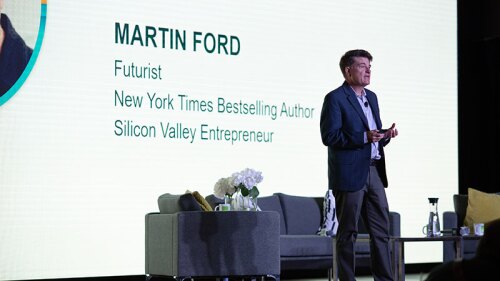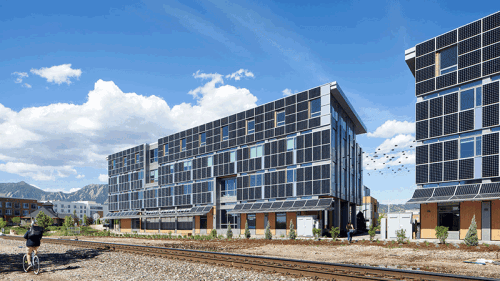
An artist’s visualisation of Beijing with the Qianmen East Hutong in the foreground. In the centre of the image are Tiananmen Square and the Great Hall of the People. The yellow structures towards the background are the Forbidden City imperial palace complex. (Beijing Institute of Design and Architecture)
Technology and contributions from all stakeholders will be crucial if Asia’s cities are to meet their net zero targets.
Earlier this year, a series of three webinars organized by ULI China Mainland covered the efforts and challenges of several cities and organizations around the world to give some focus to the efforts in Beijing, which is one of the cities in ULI’s Net Zero Imperative initiative. The discussions also focused on the Chinese capital as well as Hong Kong and Singapore.
The ULI Net Zero Imperative initiative focuses initially on eight cities around the world: Austin, Kansas City, Los Angeles, Minneapolis, and San Jose in the United States; Toronto in Canada; and Beijing and Shenzhen in China.
The five-year program involves a two-day technical assistance event in each city to help the public and private sectors develop a road map to decarbonization. ULI will run events on the ground in each city, as well as develop global resources to help members accelerate decarbonization.
Committing to Net Zero
Important themes that emerged during the ULI China Mainland webinars included the importance of engaging stakeholders if companies and cities want to move the needle on sustainability and particularly on net zero ambitions, which require wider buy-in than just government and business. Meanwhile, China’s emissions trading system (ETS), which launched last year, provides companies with a huge market for trading and the opportunity to demonstrate commitment to China’s 2060 net zero goal.
Key focus areas for the Beijing Net Zero Imperative initiative include examination of what China’s national decarbonization project means at the local level, how best to retrofit existing buildings to get them to net zero carbon, and how to manage a dynamic central business district such as Beijing’s in a net zero environment. The initiative also seeks to make a business case for real estate in Beijing to act now on decarbonization.
Jingjing Ma, general manager of Beijing-based NordiQ Engineering Consulting and moderator of the webinar, detailed the global pledge to net zero at the 2021 United Nations Climate Change Conference, known as COP26, in Scotland: 136 countries committed to carbon neutrality, accounting for 78 percent of carbon emissions, 80 percent of the world’s gross domestic product (GDP), and 62 percent of the global population. Ma also outlined how China has moved toward its goal of net zero by 2060.
Net Zero Buildings, Neighborhoods
Charlie Zhu, deputy general manager at architects and consultants Top Energy, said that China needs to start at the ground level, to move from net zero carbon buildings to net zero carbon neighborhoods, and then to a net zero carbon society. The first stage in Beijing has been newer buildings in the city’s various commercial areas, which have gone for Leadership in Energy and Environmental Design (LEED) or some other building certification.
Zhu spoke about initiatives in a new Beijing development that is seeking LEED Platinum accreditation and a refurbishment project that will upgrade an older building, and significantly reduce carbon across its life cycle.Important factors for Beijing and China reaching carbon neutrality include using renewable energy from various technologies and also more companies signing up for targets alongside the 1,029 companies in Greater China that have signed up for the Science-Based Targets Initiative.
Office Strategies That Reduce
Catherine Xiong, executive director of China project management at CBRE, spoke about her firm’s commitment to carbon neutrality by 2040, using the Science Based Targets Initiative (SBTi) and focusing on Scope 1, 2, and 3 initiatives. The company has a six-stage process from planning and design, and procurement and supply chains, through waste management, technology, emissions, and offsetting.
Xiong used the example of CBRE’s own Beijing office, where a 360-degree workplace strategy is employed to increase efficiency and reduce the amount of space needed. This strategy involves hot-desking and a paperless office. There also is a digital carbon energy management system that uses the “internet of things” to deliver real-time monitoring.
The data created provides the “foundation for future improvements,” she says, adding that CBRE changing its work practices to become more efficient was as important as monitoring and improving technology to reduce energy use.Susan Rao, associate director and chief urban planner at Arup, spoke about the low-carbon ecosystems the firm was designing for various projects in China and elsewhere and their moves toward carbon neutrality with efficient design, on-site solar, and other methods.
Singapore’s Master Plan
The webinar series also followed the experiences of two other Asian cities of moving toward a net zero carbon future. Kian Seng Ang, group director of environmental sustainability at Singapore’s Building and Construction Authority (BCA), gave an overview of the city-state’s efforts to build a more sustainable future.
Singapore has had green building measures in place for 16 years; however, they have evolved and become more ambitious. Starting with the launch of Singapore’s Green Mark accreditation system in 2005, the city-state has moved through a number of iterations of its green building master plan, culminating in last year’s Singapore Green Building Masterplan, launched by the BCA and the Singapore Green Building Council.
To create the latest master plan, there was a consultation with more than 80 built-environment stakeholders and over 5,000 stakeholders in the wider community to create the master plan’s shared vision. Over 90 percent of the stakeholders agreed that Singapore needs to do more to tackle the impacts of climate change and that new measures need to be put in place over the next five to 10 years to make all new buildings “super-low-energy buildings.”
However, the research revealed that individuals were less keen to take action themselves, with only two-thirds agreeing that individual actions such as making the choice to live and work in green buildings were an essential part of taking climate action. Ang said: “Nevertheless, it is a journey, and we will continue to engage the end users of buildings so they are fully committed to the cause.”
The headline goal for the Singapore Green Building Masterplan is to achieve three key outcomes by 2030, summarized as “80-80-80 by 2030.” This means that by 2030, 80 percent of the city-state’s buildings would be green, 80 percent of new buildings would be extremely low-energy-use buildings, and 80 percent would achieve energy efficiency improvements from 2005 levels.
Driving Higher Standards
Singapore already has 49 percent of buildings by gross floor area rated as green and will raise this percentage with a new incentive scheme for existing buildings as well as revising the Green Mark scheme to drive higher standards.In 2021, only 7 percent of new buildings were rated as super-low-energy structures, so new public-sector buildings will face increased requirements, as will new projects that are built on sites sold by public land tender. There also will be the incentive of up to 3 percent more gross floor area allowed for super-low-energy buildings.
In addition, the Singapore government is funding support for research and innovation for new solutions and funding demonstration projects that “are really pushing the boundaries,” Ang said.
Data transparency lies at the heart of Singapore’s efforts. Commercial buildings have been required to report energy use since 2013; however, now that data will be published and individual buildings will be identified.
“Data is important because it tells building owners how far they are from the norm and we want to use this as a lever to pressure building owners to do more, because when this information goes public, there will be pressure from stakeholders over why buildings are not doing so well,” Ang said.
The new Green Mark system rates buildings on energy efficiency, a key metric for Singapore, and also building intelligence, health and well-being, whole-life carbon emissions, and ease of maintenance and resilience.
Singapore is creating an online green tech directory as a resource to share knowledge and best practices with built-environment stakeholders, and to serve as a super-low-energy building smart hub.
Ang also highlighted the example of Keppel Bay Tower, an office building in Singapore that has implemented several initiatives, including installing improvements such as solar panels, an energy-efficient air distribution system, and an intelligent building control system.
Link REIT
Calvin Lee Kwan, head of sustainability and risk governance at Link Asset Management, the manager of Link REIT, Asia’s largest real estate investment trust, outlined the actions that his company, as a large property owner in Hong Kong, is taking to move to net zero. Link also owns assets in Mainland China, London, and Sydney.
Link is a subscriber to the United Nations Sustainable Development Goals and the Principles for Responsible Investment, and other sustainability-linked indices for listed companies. At present, 68 percent of the real estate investment trust’s portfolio has achieved some sort of green accreditation.
“The way Link looks at sustainability is that it’s a dynamic balance of governance, environment, social issues, and, lastly, prosperity,” Kwan said. This means transparent disclosure, an ambition to minimize the business’s negative environmental impacts, understanding and measuring how Link creates social value, and creating places that people want to visit and where tenants want to do business.
Link is focusing its sustainability efforts on climate change resilience, progress toward net zero, and sustainability reporting. The first involves an assessment of physical and transitional risks, such as completing a flood risk assessment for assets in Hong Kong and the Greater Bay Area. It has a 2035 net zero carbon goal and is aligning reporting with the International Sustainability Standards Board.
Link’s “Business as Mutual” program seeks to engage all stakeholders and encourage collective action climate resilience.
“I might build the most sustainable building, but if I don’t work with neighboring properties and the surrounding infrastructure, in the event of flooding, no one will be able to access my building. We need to work with aligned organizations to achieve common goals such as net zero,” Kwan said.



